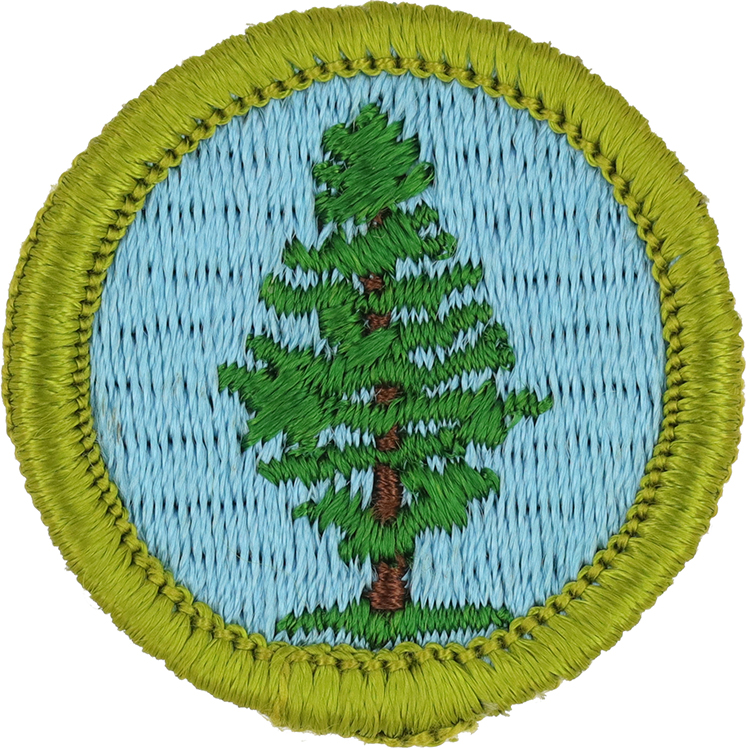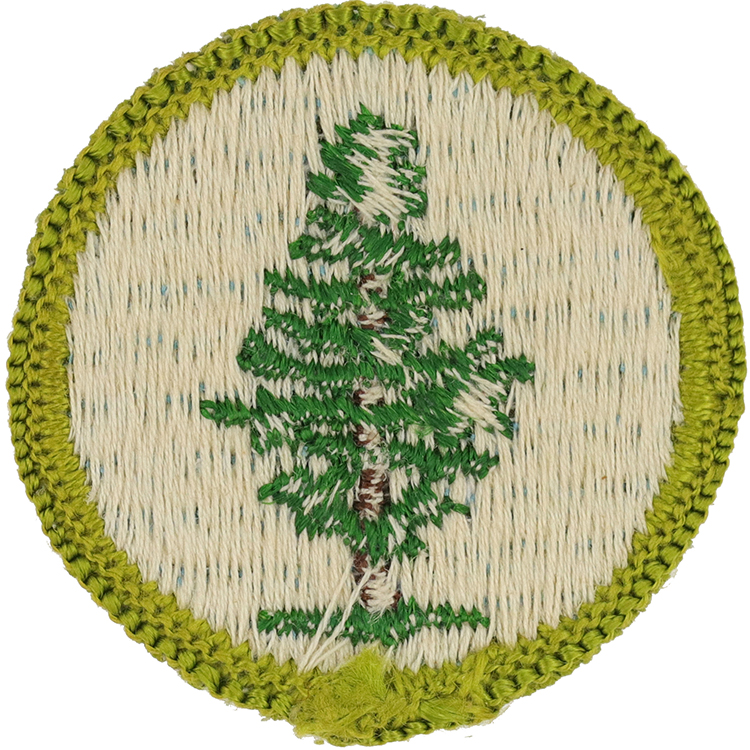
Fig. 1: Forest-G-Front
- Embroidery: Cotton thread
- Border: Merrowed

Fig. 2: Forest-G-Reverse
- Back: Starched cloth
Item Name: Forestry 1969 - 1972
Item ID: Forest-G
Collector Rating: 1
Requirements September 1958 until June 1972
1. Point out fifteen different species of forest trees or wild shrubs in the field and tell their names and chief uses. (If there are less than fifteen kinds growing locally, identify and tell the uses of those that may be found.)
2. Do one:
(a) Collect leaves or winter twigs of fifteen forest trees or shrubs; mount them in a notebook, writing the name, where it grows in the U. S. and the chief uses.
(b) Obtain wood samples of ten different trees and tell some of the uses of each kind of wood.
3. (a) Describe the value of forests in protecting soil and building fertility, regulating the flow of water, wildlife management, and as recreational areas. Tell from what watershed or other source your community obtains its water. (b) Describe briefly the part that forest products play in our everyday life.
4. (a) Make a diameter tape or Biltmore Stick. Show how to determine the height and diameter of trees. Estimate the board foot volume of three trees selected by the Counselor. OR (b) Examine ten stumps or logs and discuss the reasons for variations in the rate of growth shown by the rings.
5. Describe what is meant by sustained yield forestry.
6. Do one:
(a) Mark a 1/4-acre plot for an improvement cutting (using chalk or paint to mark trees for removal) and tell why you would remove the marked trees.
(b) Help your Counselor or a forester make an improvement or harvest cutting.
(c) Grow and tend for one year seedlings of forest trees or shrubs.
(d) Plant 100 seedlings for future lumber production, pulpwood, or for soil and water conservation.
(e) Collect 20 mature cones from a coniferous tree, extract seed and run a germination test on the seed.
(f) Assist is planting a shelter belt or windbreak and tell why the work is important.
(g) Help in some range improvement project approved by your Counselor.
7. (a) Describe the damage to forests and watersheds resulting from fire, insects, tree diseases, overgrazing, unwise cutting practices. Tell what is being done to reduce this damage. (b) Tell what to do if a fire is discovered in woodlands. (c) Take part in a forest fire prevention campaign or build a fire lane of at least 100 yards at a location designated by a local fire warden or forester, or counselor.
8. Do one:
(a) Visit a logging operation, pulp or paper mill, wood preserving plant, furniture factory, veneer plant, mill working plant, saw mill, turpentine still, or some other wood-using industry and write a report of about 500 words telling what the raw material is, where is comes from, and how the finished product is made, how products are used, and how waste materials are disposed of.
(b) Visit a managed public or private forest area or watershed area with its manager or supervisor. Write a story of about 500 words on how they manage the forest to grow repeated crops of timber to protect the watershed, or to provide other services and benefits.
(c) Help a forester, wildlife expert, or your Counselor in some forest project that will benefit wild animals.
(d) Help a forester mark a hiking or ski trail, improve a campground, or make some other improvement for recreational use.
(e) Help your Counselor or a forester with some other type of improvement, or furnish evidence acceptable to the Counselor of some other activity or accomplishment of benefit to the forest or related resources.
(f) Help a grazing officer make a survey.
* This merit badge may be earned as a 4-H'er, by completing a club project in that subject or as an FFA member by meeting these requirements through the FFA supervised farming program.


